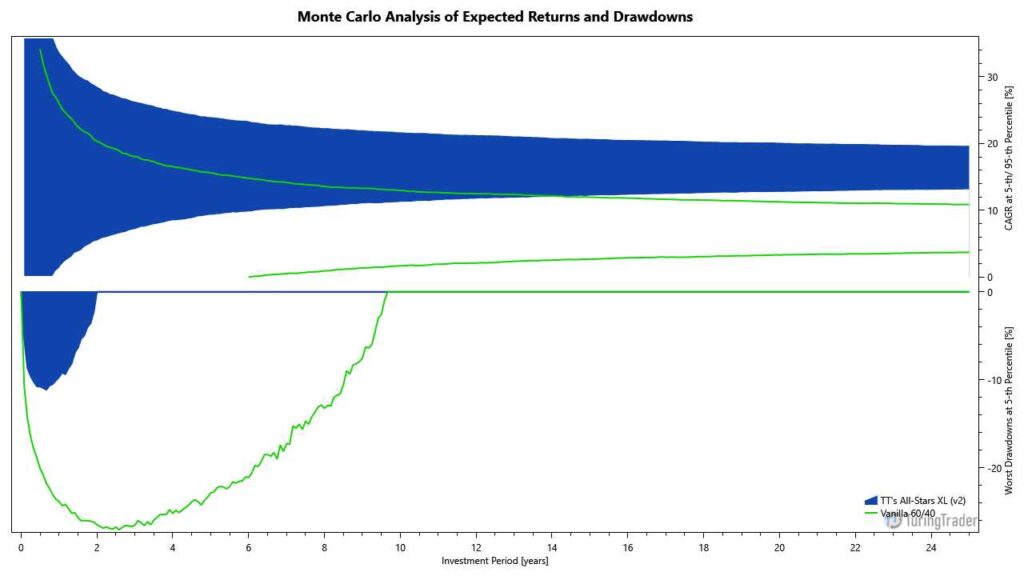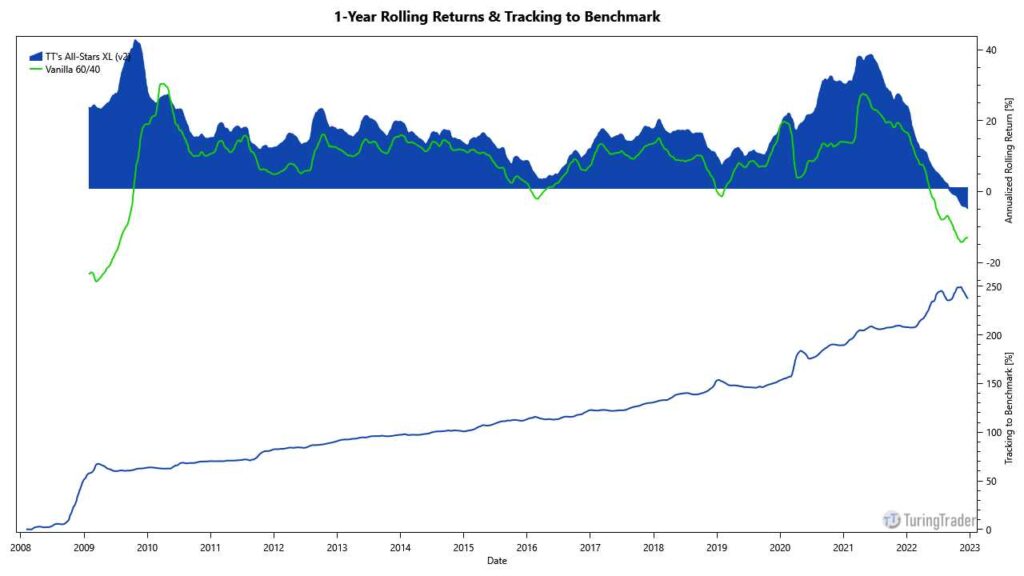Summary
- Objective: balanced growth
- Type: momentum strategy
- Invests in: ETFs tracking stocks, bonds, real-estate, commodities
- Rebalancing schedule: monthly
- Taxation: 60% short-term capital gains
- Minimum account size: $5,000
Mebane T. Faber is co-founder and Chief Investment Officer of Cambria Investment Management. Together with Eric W. Richardson he published the Ivy Portfolio in his book with the same name in 2009.
The strategy aims to replicate the conservative mechanics of Ivy-league endowments. To achieve its goal, the Ivy Portfolio selects the top-performing assets from a list of ETFs covering all major asset classes.
Rebalancing is performed once per month, making the portfolio low maintenance.
Performance
This table shows the portfolio’s key performance metrics over the course of the simulation:
The following chart shows the portfolio’s historical performance and drawdowns, compared to their benchmark, throughout the simulation:
This chart shows the portfolio’s annual returns:
The following charts show the Monte-Carlo simulation of returns and drawdowns, the portfolios 12-months rolling returns, and how the portfolio is tracking to its benchmark:


Asset Allocation
The portfolio last required rebalancing after the exchanges closed on @last-rebal@. Due to fluctuations in asset prices, the exact allocations vary daily, even when no rebalancing occurred. The current asset allocation is as follows:
Sign up for our FREE Basic membership to see the asset allocation.
Sign up for our FREE 14-day trial to see the asset allocation.
Strategy Rules
Faber’s book contains multiple variants for the Ivy Portfolio. Our implementation is based on the book’s 5-asset universe with a rotation system. In our testing, this strategy had the most value for investors. The operation of the portfolio can summarized as follows:
- trade ETFs representing U.S. stocks, international stocks, credit bonds, real-estate, and commodities
- calculate a momentum score as the average of the 3-months, 6-months, and 12-months momentum
- rank the assets by their momentum score and pick the top 3 assets
- invest in these assets, unless their momentum score is negative
- if any momentum score is negative, substitute the asset with T-bills
The full rules along with their rationale is described in Faber’s book The Ivy Portfolio. Further, the full C# source code is available as part of the TuringTrader.org open-source project.
The Ivy Portfolio follows a ‘win more by losing less’ philosophy: it attempts to lead by avoiding deep drawdowns during recessions. Therefore and like most strategies of this kind, performance should be contemplated over the full economic cycle.
Diversification
The method of selecting three out of five asset classes ensures that the Ivy Portfolio remains diversified across multiple markets at all times. This diversification effectively limits tail risk, however no more than a passive 60/40 allocation.
Returns & Volatility
Faber’s portfolio managed the 2008 recession quite well, and also fully picked up the rebound of 2009. However, as with all momentum strategies, the reaction to market changes is often delayed. Therefore, the Ivy Portfolio is often suffering more than passive portfolios from any short-term market turbulence, as seen in 2011, 2013, 2015, and 2018.
The Monte-Carlo simulation reveals that the Ivy Portfolio does not improve the overall distribution of returns when compared to a passive 60/40. While the backtest shows a significantly reduced maximum drawdown, we have low confidence that this will always be the case moving forward.
Account & Tax Considerations
When the strategy rotates ETFs, it triggers taxable events. However, over the course of the last economic cycle, the strategy has often held assets long enough to qualify for long-term treatment of capital gains. Nonetheless, the Ivy Portfolio will work best in tax-deferred accounts.
The strategy invests in only three ETFs at a time. Therefore, it can function properly with as little as $5,000 of capital.
